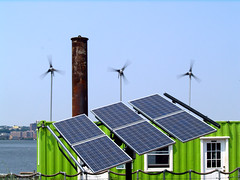 Image by David Reeves via Flickr
Image by David Reeves via Flickr
Renewables: The Final Frontier
Why historian Vaclav Smil thinks there are no easy solutions to our energy problems. . . When it comes to energy, the scientist who best exemplifies Vulcan logic is Vaclav Smil. The world's foremost energy historian, he began a recent essay with this blunt statement: "Our transition away from fossil fuels will take decades -- if it happens at all.". . . He does not believe that our cars will soon be powered by fuel cells or pyrolyzed turkey guts, that clean coal can solve the climate problem, or that venture capital will discover an energy analogue to the cellular phone.
Al Gore's proposal to re-power America with renewable energy in a decade is "delusional," Smil writes. "Gore has succumbed to Moore's curse, the belief that performance improvement in energy systems can model that of computer processing power." . . .
Given climate realities, we desperately need a rapid energy transformation, but wishing can't make it so. As a Vulcan might say, what is desirable is not necessarily probable. Change takes time. James Watt's steam engine revolutionized the mining and transportation of coal, but it still took a century for coal to displace wood. Solar photovoltaic cells were invented 55 years ago, and yet today in the U.S. they produce less electricity than Glen Canyon Dam. Eight years after its introduction, the ingenious Prius has yet to become 1 percent of the automotive fleet.
Like it or not, Smil believes we are captive to past investments, to the multi-trillion-dollar energy networks we have already created, and, above all, to the scale of our energy appetites. Only the last of those factors seems amenable to rapid change, and thus his advice to President Obama: "Explain to the nation that Americans, who consume twice as much energy per capita as rich Europeans (and have nothing to show for it), should try to live within some sensible limits, which means using less fuel not more."
. . . We have much larger appetites today. Melanie Moses, a biologist at the University of New Mexico, calculates that a typical North American consumes energy at a rate sufficient to sustain a 66,000-pound primate.
That's a very big ape, and Smil is not the only one asking whether it's realistic to meet his gargantuan appetite with wind and solar, dilute flows of power that today provide less than 1 percent of U.S. energy. Unlike oil shale -- the thermodynamically doomed effort to turn chicken manure into chicken salad -- wind, solar and geothermal have high energy returns and a bright future. Nonetheless, it will take many doublings before they will meet a significant percentage of our needs . . . .
In his personal life, Smil is an avid conservationist, proud of his super-efficient house and frugal Honda. In his recent work, there is a hint of frustration with what he sees as the cannibalization of our host planet. Contemplating our journey to the future, where no man has gone before, he writes, "I am always trying to imagine what would be the verdict of a sapient extraterrestrial informed about the behavior of affluent Earthlings."

![Reblog this post [with Zemanta]](http://img.zemanta.com/reblog_e.png?x-id=444609e7-d4a5-4038-8faa-27ba4b76861d)




No comments:
Post a Comment